Traditional Bonsai Pots USA is not just about style, but it’s the key to keeping your bonsai healthy and true to its art form.
In the US, traditional bonsai pots are most commonly made of ceramic, particularly stoneware fired clay. These pots are favored for their versatility, visual appeal, and durability.
While other materials, such as concrete or plastic, are also used, ceramic offers a classic look and feel that complements various bonsai styles.
Traditional bonsai pots in the United States are typically made of high-fired ceramic or stoneware. They are often unglazed, especially for conifers, and come in classic shapes such as rectangles and ovals.
While ceramic pots are traditional, plastic pots are also used, particularly for training young dwarf trees. If you’ve been struggling with cracked terracotta in winter, poor drainage, or pots that don’t match your tree’s beauty, the answer lies in using ceramic or high-fired stoneware pots designed for bonsai plants.
These traditional containers, such as Tokoname ware from Japan or unglazed Yixing clay from China, are shallow to control root growth, have drainage holes, feet, and wire holes for stability, and come in rectangular, oval, round, and cascade shapes to suit any style.
In the USA, you can choose between glazed pots for vibrant color or unglazed finishes for a rustic, natural look, each crafted to balance durability, proportion, and the harmony that bonsai tradition demands.
USDA regulations require the removal of all growing media (soil) before shipping bonsai to the United States.
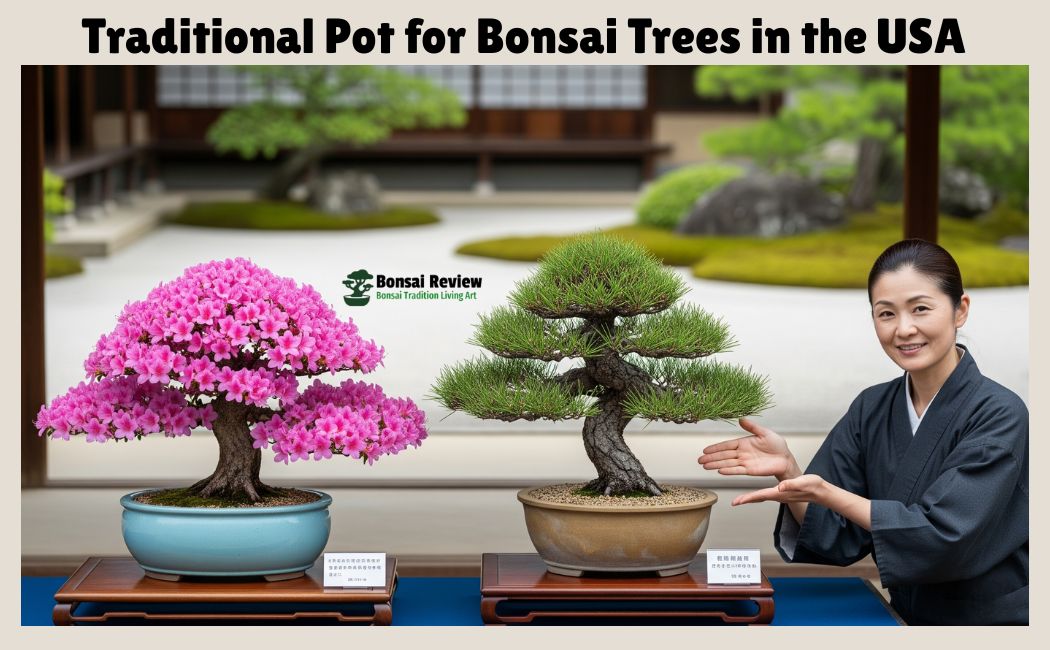
What Makes a Bonsai Pot “Traditional”?
A bonsai pot is called “traditional” when it follows the shapes, materials, and design rules that bonsai artists have used for hundreds of years.
These unique bonsai pots began in China with penjing and were refined in Japan, where the focus shifted to simple shapes that let the dwarf tree be the star.
You’ll see most traditional pots made from ceramic or high-fired stoneware, because they’re strong, don’t soak up water, and can survive many seasons.
Famous examples include Tokoname ware from Japan and unglazed Yixing clay from China, both valued for their handmade quality and rich history.
The unique pot’s design also matters. Traditional pots are shallow to keep roots in check, with drainage holes so water never sits inside. Small feet lift the pot for air flow, and wire holes help you anchor the tree securely.
The shapes, rectangular, oval, round, or cascade, aren’t random; each one pairs with a specific bonsai style to create balance and harmony.
When you choose a traditional bonsai pot, you’re not just buying a container. You’re keeping your tree healthy, honoring a centuries-old craft, and showing the same respect for detail that bonsai masters have for generations.
Which Traditional Bonsai Pots Are Popular in the USA?
One of the most respected types is Tokoname ware from Japan. These pots are often unglazed, with a warm, earthy tone that blends beautifully with conifers and formal styles.
From China, unglazed Yixing clay is another favorite, known for its rich, natural color and handmade craftsmanship. Both types have been used for centuries and are still sought after by bonsai artists in the USA.
You might also see pots made from concrete, resin, or plastic. While these can be cheaper and lighter, they don’t have the same cultural value or long-term durability. Traditionalists prefer ceramic or stoneware because they age gracefully and enhance the art of the tree.
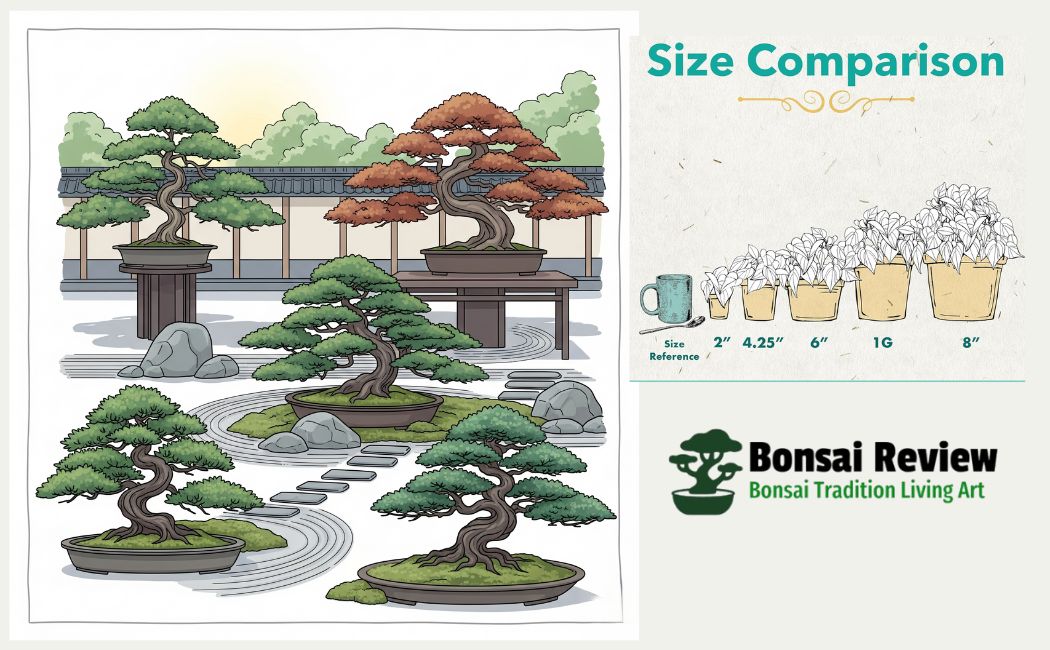
Are Materials Used in Traditional Bonsai Pots?
When you pick a pot for your bonsai plants, the material is just as important as the shape. In traditional bonsai culture, ceramic and high-fired stoneware are the gold standard. These pots are fired at very high temperatures, making them strong, non-porous, and able to handle changes in weather without cracking.
- Ceramic/Stoneware: The most common and traditional material for bonsai pots. It’s known for its durability and ability to absorb and retain water, which is important for the tree’s health.
- Plastic: While not traditional, plastic pots are often used for training bonsai, especially young trees. They are lightweight, durable, and can be more affordable than ceramic.
Which Pot Shape Is Best for Your Bonsai Style?
Traditional bonsai pots come in various shapes, including rectangular, oval, and round, each suited to different bonsai styles.
- Rectangular: Often chosen for upright bonsai styles, offering a classic, formal look.
- Oval: Good for a variety of styles, particularly those with a more relaxed form.
- Other shapes: Cascade, round, and other irregular shapes are also used, depending on the style of the bonsai.
Rectangular pots are often used for formal upright styles, while oval and round pots are popular for informal and cascading styles.
Colors and Finish: Traditional bonsai pots in the USA.
- Unglazed Pots: Often favored for conifers and evergreens, providing a natural, earthy look. Ceramic pots can be glazed (coated with a glassy finish) or unglazed.
- Glazed Pots: Can be used for deciduous trees and those with colorful flowers or fruits, where a bit more visual interest in the pot is desired.
- Glazed pots offer a wider range of colors and finishes, while unglazed pots have a more rustic, natural appearance.
Other Considerations: Traditional bonsai pots in the United States.
The size and depth of the pot should be proportional to the tree’s trunk and overall size, with general guidelines based on the tree’s height and trunk diameter.
- Drainage: All bonsai pots should have drainage holes to allow excess water to escape.
- Size: The pot should be appropriately sized for the tree, typically about one-third to one-half the height of the tree, according to Garden Health.
- Aesthetics: The pot should complement the tree’s style and overall appearance.
Choosing the right material means your pot will protect the roots, last for years, and stay true to the traditional look that bonsai is known for.
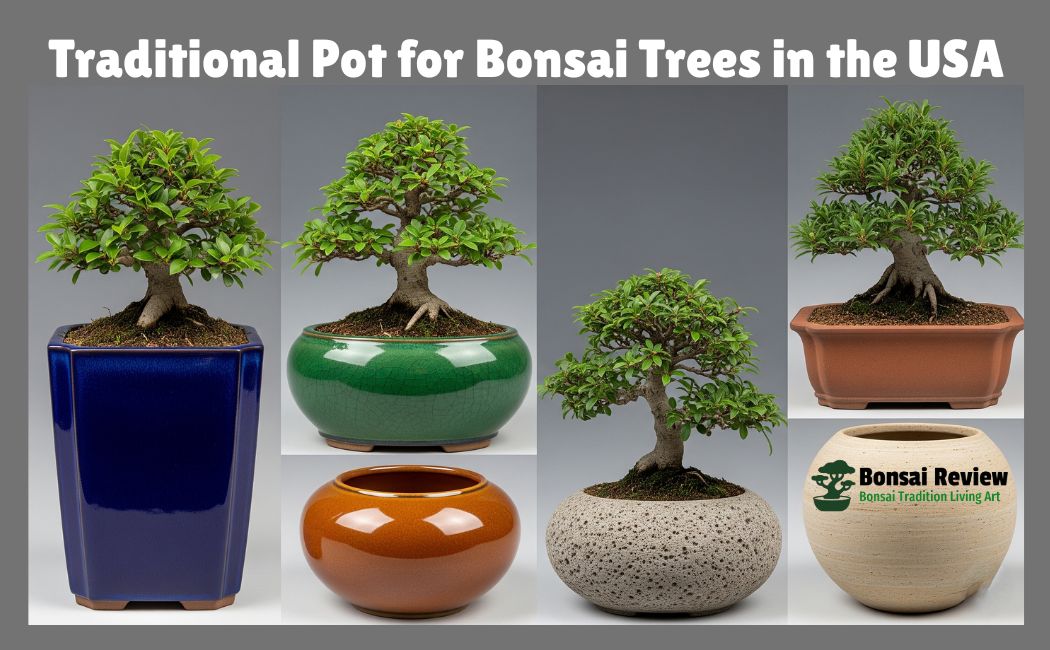
Glazed vs. Unglazed Pots: How Do You Choose the Right Traditional Bonsai Pot?
When you choose a traditional bonsai pot, the surface finish plays a big role in how the tree looks. You’ll usually pick between glazed and unglazed pots. Both are beautiful, but they suit different trees and styles.
Basically, Glazed pots have a smooth, shiny coating that comes in many colors. They’re popular for flowering or fruiting bonsai because the bright finish complements the blooms or berries.
Unglazed pots, on the other hand, have a more natural, earthy look that works well with conifers and formal styles, where the tree’s shape is the main focus.
Here’s a quick guide to help you decide:
| Feature | Glazed Pots | Unglazed Pots |
| Appearance | Smooth, shiny finish in many colors | Matte, earthy texture in natural clay tones |
| Best For | Flowering bonsai (azalea, cherry blossom), fruiting bonsai (apple, crabapple) | Conifers (pine, juniper), formal upright styles |
| Traditional Use | More common in Japanese bonsai for seasonal displays | Highly valued in both Japanese and Chinese bonsai traditions |
| Pros | Wide color choices, easy to clean | Rustic look, hides minor scratches, ages beautifully |
| Cons | It can distract from the tree if the color is too bold | Limited color variety, may stain over time |
| Example Styles | Oval, round, shallow rectangle | Rectangular, drum-style, cascade |
When you match the finish to the tree, the pot becomes part of the overall design, not just something that holds the soil.
Shapes and Styles of Traditional Bonsai Pots
The shape of a traditional bonsai pot is not chosen at random, and it’s part of the design that keeps your tree balanced and beautiful. In bonsai tradition, every shape has a purpose, and matching the right pot to the right tree style is key.
Rectangular pots are a classic choice for formal upright bonsai like Japanese Black Pine or Chinese Elm. Their straight edges reflect the tree’s structured shape.
Oval pots have softer lines, making them perfect for informal upright bonsai such as Juniper or Maple dwarf plants. They create a gentle, flowing look.
Round pots are often used for root-over-rock or semi-cascade styles, giving a sense of harmony from every angle.
Cascade pots are tall and deep, designed for dramatic cascade and semi-cascade bonsai, like certain Junipers, where the branches flow down below the rim of the pot.
Here’s a quick style guide for matching shapes:
| Pot Shape | Best Bonsai Styles | Why It Works |
| Rectangular | Formal upright, twin-trunk | Strong lines match formal, structured growth |
| Oval | Informal upright, broom style | Soft curves complement natural, flowing branch patterns |
| Round | Root-over-rock, literati | Balanced from all sides; no fixed viewing front |
| Cascade | Cascade, semi-cascade | Deep pot supports trailing branches and protects roots from drying |
| Drum-style | Powerful, masculine trees | Thick walls and a solid base convey strength |
When you match pot shape, tree species, and style, you create the visual harmony that bonsai masters aim for traditional pot for bonsai trees in the USA.
You’ll find these shapes in Tokoname ware, unglazed Yixing clay, and modern handmade stoneware, giving you traditional beauty with local availability.
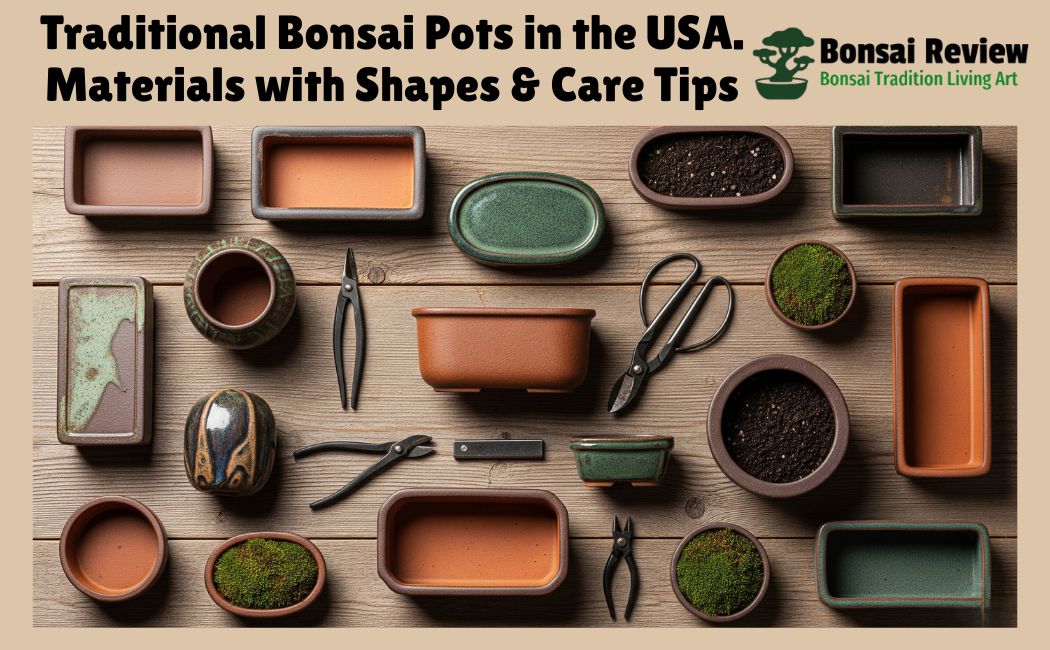
Size and Depth Guidelines for Traditional Bonsai Pots
Choosing the right size and depth for your bonsai pot is as important as choosing the tree itself.
In traditional bonsai practice, there are clear rules to help you decide that come from centuries of Japanese and Chinese bonsai culture.
A common rule is that the pot length should be about two-thirds the height of the tree. This keeps the design balanced and avoids a crowded look.
For example, if your Japanese Maple bonsai is 30 cm tall, a pot around 20 cm long is ideal. The pot depth is usually about the same as the diameter of the tree’s trunk at its base.
This depth supports healthy root spread without making the pot look heavy. For cascade styles, you need extra depth to anchor the roots and balance the flowing branches.
Here’s a quick reference table:
| Tree Height | Pot Length Rule | Pot Depth Rule | Best Styles |
| 15–25 cm (Shohin) | 2/3 tree height | Same as trunk base width | Mame, Shohin, Miniature upright |
| 25–40 cm (Small bonsai) | 2/3 tree height | Same as trunk base width | Informal upright broom |
| 40–60 cm (Medium) | 2/3 tree height | Same as trunk base width or slightly deeper | Formal upright, twin-trunk |
| Cascade bonsai | Pot depth is more than trunk width | Depth supports hanging branches & root stability | Cascade, semi-cascade |
| Root-over-rock style | Slightly longer than upright | Shallow to show the rock base | Root-over-rock, literati |
When buying Tokoname clay pots or unglazed Yixing pots, you’ll often see these sizes labeled for different bonsai classes like Shohin, Kifu, or Chuhin. Following these traditional guidelines ensures your bonsai not only looks right but also grows strong and healthy.
Choosing the Right Glaze and Color for Traditional Bonsai Pots
In traditional bonsai display, the glaze and color of the pot are more than decoration, and they help create harmony between the tree, pot, and overall composition.
Japanese bonsai tradition often favors unglazed pots for conifer species like Japanese Black Pine or Shimpaku Juniper. The earthy browns and reds of Tokoname Shudei clay give a natural, timeless look that matches the rugged bark and evergreen foliage.
For deciduous trees, subtle glazed finishes are common. Soft celadon green or light blue complements the fresh spring leaves of a Japanese Maple, while warm cream or beige tones enhance the autumn colors of a Zelkova. The glaze should never overpower the dwarf tree; instead, it should echo the tree’s seasonal character.
Some styles use matte glazes to avoid too much shine, especially in formal displays like Kusamono companion plantings. In contrast, bright glazes are more common in Chinese Yixing pottery, where deeper blues or mossy greens are used for artistic contrast.
For example, if you have a flowering Satsuki Azalea, a pale pink or white glazed pot can highlight its blooms without stealing attention. On the other hand, a rugged literati-style juniper will look most authentic in a dark, unglazed Tokoname pot with sharp corners, enhancing its refined yet wild spirit.
The right glaze and color choice not only honors bonsai tradition but also shows the grower’s sensitivity to the tree’s story and season.
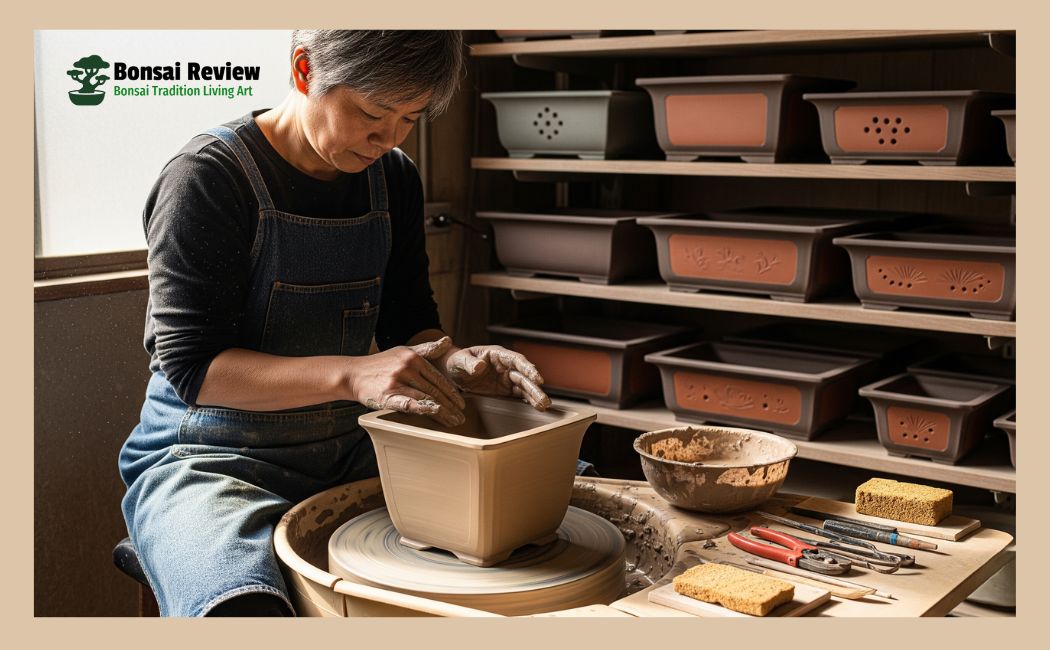
Decorative Features: Why Do Bonsai Experts Prefer Traditional Pots?
Traditional bonsai pots are not just plain containers, and many include subtle decorative details that add to the overall harmony between the pot and tree. These features reflect centuries of craftsmanship, especially in famous pottery like Tokoname ware.
One common detail is the carved feet or raised legs that lift the pot slightly off the ground. This allows air circulation under the pot, which helps keep the roots healthy and prevents water from pooling.
You’ll often find pots with “cloud corners,” gently curved edges that soften the pot’s lines and give it an elegant appearance without distracting from the tree.
Some pots feature motif engraving or stamped symbols inspired by nature, such as leaves, waves, or traditional Japanese patterns. These carvings add texture and character but remain subtle to maintain the bonsai’s focus.
For example, a Tokoname pot might have a small engraved pine needle design to complement a pine bonsai.
In the USA, artisan potters often create bonsai pots that blend these traditional features with modern touches. Handmade pots with unique glazes and carefully carved feet are popular among bonsai collectors who want a personal connection to their pot’s origin and story.
Decorative details are a small but meaningful part of the bonsai art of living. They show respect for tradition while enhancing the tree’s beauty.
Where to Find Traditional Bonsai Pots in the USA?
If you’re ready to buy a traditional pot for your bonsai tree in the USA, you have several good options. Many bonsai enthusiasts look for authentic Tokoname ware or unglazed stoneware pots that reflect classic styles and quality craftsmanship.
Online stores like Bonsai Outlet, Stone Lantern, and House of Bonsai offer a wide selection of traditional pots, from glazed to unglazed, in various shapes and sizes.
These shops often import authentic Japanese pots or sell handmade American stoneware inspired by bonsai traditions. Shopping online gives you access to rare styles and the ability to compare prices and features easily.
For a more hands-on experience, bonsai nurseries and garden centers across the USA sometimes stock traditional pots, especially in regions with strong bonsai communities like California, Oregon, and Florida. Visiting these places lets you see the pot’s weight, color, and texture before buying.
You can also find artisan pottery fairs and bonsai exhibitions where local potters showcase unique handmade pots. These events are great if you want a one-of-a-kind container that blends tradition with American craftsmanship.
Whichever route you choose, remember that a quality traditional pot supports your bonsai’s health and beauty for years to come. It’s worth investing time and care into selecting the right one.
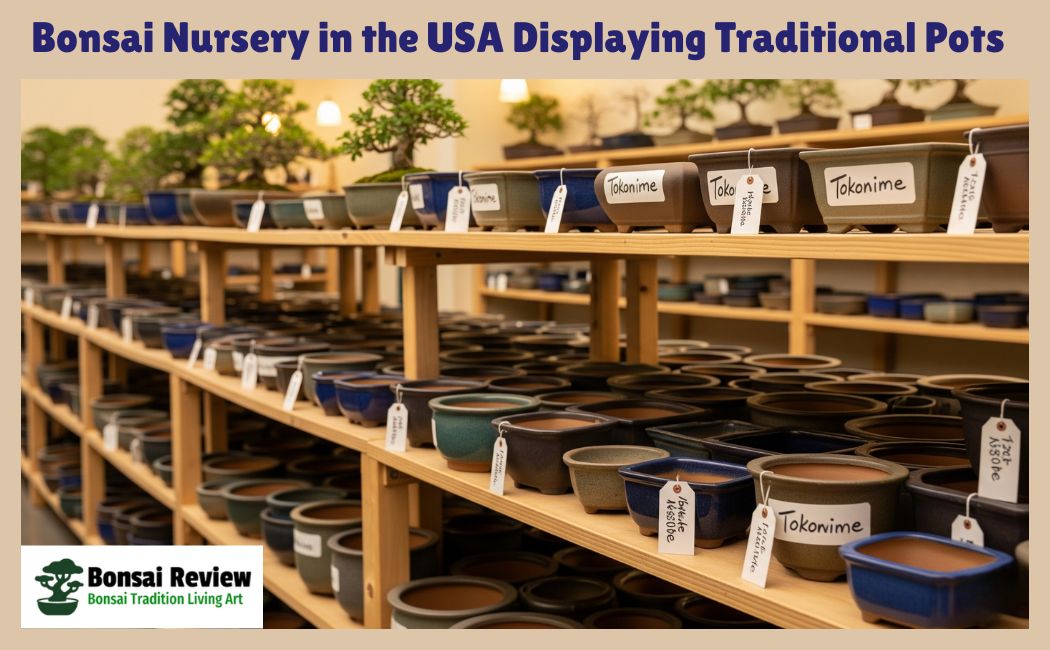
How Do You Care for Your Traditional Bonsai Pot?
Taking care of your traditional bonsai pot is just as important as caring for the tree itself. A well-maintained pot lasts longer, looks better, and helps keep your bonsai healthy.
Start by cleaning your pot regularly. Mineral deposits and soil can build up over time, especially on unglazed pots.
Use a soft brush and warm water to gently remove dirt without damaging the clay surface.
Avoid harsh chemicals that can harm the pot’s finish or the tree’s roots. If you live in a place with cold winters, like many parts of the USA, protect your pot from freeze damage.
Unglazed pots, even stoneware, can crack if water trapped inside freezes. Move your bonsai indoors during freezing weather or wrap the pot with insulating material to reduce the risk.
Be careful with antique or Vintage collector pots, such as rare Tokoname ware. These may require extra gentle handling and should not be exposed to rapid temperature changes or physical shocks.
Finally, when repotting, check the pot for cracks or chips. Repair small damage promptly or replace the pot to avoid root injury.
By caring for your bonsai pot well, you ensure that it continues to support your tree’s beauty and health for many seasons.
Conclusion: Traditional Bonsai Pots USA: Ceramic, Stoneware & Glazed vs. Unglazed Explained.
Choosing the right traditional pot for bonsai trees in the USA is more than just picking a pretty container.
It’s about finding a pot made from durable materials like ceramic or Tokoname stoneware, designed with proper drainage, shallow depth, and classic shapes that match your tree’s style.
If you prefer a glazed finish for color or the natural look of unglazed clay, the right pot supports your bonsai’s health and enhances its beauty.
By understanding the history, materials, and design of traditional bonsai pots, and knowing where to find quality options in the USA.
You’re well on your way to making a smart choice. Taking care of your pot will help it last for years, keeping your bonsai thriving and true to its art.
With the right traditional pot, you give your bonsai the foundation it deserves, blending function, tradition, and style perfectly in your home or garden.
Bonsai beginners and lovers learn all about traditional bonsai pots used in the USA, from Japanese Tokoname ware to glazed and unglazed ceramic pots, and how to care for them.
Exclusive article: How to Choose Vintage and Antique Bonsai Pots?
FAQs about Traditional Bonsai Pots in the USA.
1. What is a traditional bonsai pot?
A traditional bonsai pot is typically made from ceramic or high-fired stoneware like Tokoname ware from Japan. These pots have shallow depths, drainage holes, and classic shapes designed to support bonsai health and aesthetics.
2. Why are Tokoname pots popular for bonsai?
Tokoname pots are prized for their exceptional durability, meticulous craftsmanship, and natural, unglazed finishes that harmonize beautifully with various bonsai styles. They are one of Japan’s Six Ancient Kilns and have been used for centuries.
3. Can I use glazed pots for all bonsai trees?
Glazed pots are great for flowering or fruiting bonsai because of their colorful finishes. However, for conifers or formal styles, unglazed pots are often preferred to keep a natural, rustic look.
4. Where can I buy traditional bonsai pots in the USA?
You can find traditional bonsai pots online at stores like Bonsai Outlet and Stone Lantern, at bonsai nurseries, garden centers, and bonsai shows across the country.
5. How do I care for my bonsai pot?
Clean your pot regularly with warm water and a soft brush. Protect unglazed pots from freezing temperatures by moving them indoors or insulating them. Handle antique pots with care to prevent damage.
6. What size bonsai pot should I choose?
A good rule is that the pot length should be about two-thirds the height of your bonsai tree, and the depth should match the trunk diameter to support healthy root growth.
7. Can you bring a bonsai to the US?
According to the USDA, any growing media, including soil, must be removed from the artificially dwarfed plants (bonsai or penjing) before shipment to the United States.
8. What is the cheapest alternative to bonsai pots?
For dwarf trees that are still at the beginning of their Bonsai beginner training, you don’t need expensive Bonsai pots. Plastic training pots or simple flower bowls with a drainage hole, which can often be found in most homes, are sufficient.
9. Are plastic pots good for bonsai?
Plastic pots tend to retain moisture better than other materials. This can be beneficial for certain bonsai species that prefer consistently moist soil.